1964: Johnson's War on Crime
The New “War on Crime”
President Lyndon B. Johnson meets with Civil Rights Leaders Martin Luther King Jr., Whitney Young, and James Farmer in the Oval Office, 1964.
Source: OSU.EDU
In 1964, as President Johnson prepared to sign the Voting Rights Act into law, he also signed the Law Enforcement Assistance Act. This Act represented a part of Johnson’s new “war on crime,” which aimed at cleaning up urban violence and stemming the tide of what some saw as a downward trend towards increased societal disintegration.
The Act “offered a response to the threat of future disorder by establishing a direct role for the federal government in local police operations, court systems, and state prisons for the first time in American history” (Hinton, 2016, p. 2).
Federal and Local Law Enforcement “Modernization”
Police arrest man during the Watts Uprisings in Los Angeles, August 13, 1965. Courtesy of Library of Congress.
Source: Boston Review
The Law Enforcement Assistance Act and its sister the Safe Streets Act of 1968, not only increased the power of the federal government to engage in local policing, but they also provided millions of dollars to “promote the modernization of law enforcement” (p. 2). Existing views within criminology asserted that Black individuals were predisposed towards violence. The expansion of America’s “carceral state” meant that the law enforcement prejudice against African Americans was now better funded and organized at the federal level.
Historian Elizabeth Hinton (2016) noted that “[i]t is one of the essential ironies of American history that this punitive campaign [the war on crime] began during an era of liberal reform and at the height of the civil rights revolution, a moment when the nation seemed ready to embrace policies that would fully realize its egalitarian founding values” (p. 1). In reality, Johnson’s “war on crime” tapped into the systemic racism already prevalent in America’s criminal justice system. As civil right protests and protests against the Vietnam war erupted across the United States, the Johnson Administration blamed African American men (p. 13). Describing this focus, Hinton (2016) noted
This group [Black men] quickly emerged as the foremost target of federal policymakers. It seemed that antipoverty programs had failed to reach the ‘hard-core’ black urban youth who appeared particularly susceptible to collective violence, and by extension, crime. Without evoking race explicitly, the White House and Congress then built a set of punitive policies that focused on controlling this group by expanding the field of surveillance and patrol around them. (p. 13)
Policing Prejudice
The “war on crime” thus became a justification for law enforcement to go after Vietnam war protesters and to keep African American men under surveillance. Given the deeply ingrained ideology of Black men as naturally violent and aggressive, more prone to commit crime and more resistant to government, it is not surprising that most law enforcement officials continued arresting Black men in much larger quantities than white men.

